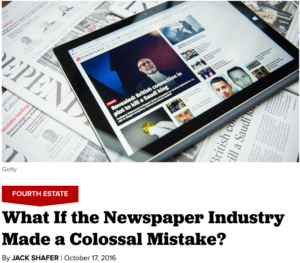Interviews with experts yield valuable information

By Kevin Slimp
I live a charmed life. Last week, I spent four days with nine of the top newspaper experts in the business, along with journalists from 22 states at The Newspaper Institute in Knoxville, Tenn.
When attendees get home, they often write me about their experiences. More times than not, they mention the thrill of spending time with these leaders they’ve followed for years.
In addition to spending time with these “big names” at the Institute, I often get to visit and work with them at other times. In September, I began an experiment that has turned out quite nicely. As part of a project a group of us began working on last year, I created an online radio station and began interviewing folks I thought would be of interest to journalists. The results have been fascinating, and I decided to share quotes from a few of the interviews in this column.
Ed Henninger, Sept. 13, 2016

Having developed a close relationship over the past 10 years, I invited Ed Henninger to be my first guest on “News Guru Radio.” I expected the conversation to revolve around design, but as is often the case during these interviews, the subject turned to more pressing matters. Ed brought up the topic of “synergy,” sharing memories from his days as a daily newspaper editor.
“Even before the web, larger papers started chasing their tails. ‘Synergy’ was where we all of a sudden decided to join efforts with the television newsroom. I remember sitting in meetings and thinking,’ ‘This is just so much garbage. Who came up with this?’”
Ed shared his concern too many larger papers are more interested in cutting than growing.
“Too many stopped looking for ways to generate revenue and started looking for ways to cut costs. Not all are that way. But a lot of larger companies are no longer looking for ways to generate revenue. So the first thing they do when they buy a paper is to start firing people.”
Tim Smith, Sept. 19, 2016

Tim was my third guest on the program, and several listeners wrote in about all they had learned during the interview. Tim had a lot to say about treating the customer right: “The customer is thinking, ‘This is the fourth salesperson I’ve seen in the last two years.’ They’re asking ‘What’s going on? have you got a revolving door?’ I don’t blame them for wondering if they should be putting money into this paper.”
I asked Tim if he saw a lot of folks doing well selling digital advertising at newspapers.
“I see newspaper people taking from the print side to the digital side. The paper is the bread and butter, but I’ve seen companies pushing digital. I’m not going to shove something digital down my customers’ throats if they don’t need it.”
Tim discussed the tendency for metro papers to force digital onto their customers, rather than giving them what they want.
He didn’t mince words when he told me, “You’re going down the road Wells Fargo went down. I’m trying to sell stuff they don’t need (digital), and I’m trying to hide it or bury it so they don’t see it.”
He added that digital sales have become too much “‘this is what I have’ instead of ‘this is what I need.’”
Karl Kuntz, Sept. 27, 2016

Kuntz is a household name in photojournalism, and I wasn’t surprised we had a big audience for the interview. We spoke for 30 minutes, and Karl gave some much needed advice on getting great pictures.
Speaking of sports photography, he said, “I search for a different way of looking at a picture. Once, when preparing to shoot a big game, I knew if Ohio State won, everyone would storm the field. I got to the stadium two hours before the game, got in my position, and stayed in the same spot the whole game to get two pictures. One was a six-column front page picture of the team carrying the quarterback off the field. Later, people would say, ‘That’s kind of a lucky picture.’ It wasn’t luck. It was planning.”
He went on to advise listeners to look for a story off the field. “Don’t just shoot action pictures,” he warned. “Sometimes the storytelling picture is not the action picture.”
Chris Ashfield, Sept. 30, 2016

Chris is a community publisher in Saskatchewan. I learned during the interview that he had just purchased a paper previously owned by a large national corporation. He told us how things were coming along after transforming the newspaper from a corporately-owned paper to a community paper.
He described the transformation when he said, “We’re getting more and more subscribers every day. We’re seeing advertisers come in and sign year-long contracts.”
I thought I might be hearing things, so I asked, “People are subscribing to the newspaper?”
“Believe it or not, people actually want to read the newspaper,” Ashfield noted, “And advertisers see that we are serious about covering the community and they like it. They’re coming back to community newspapers as well.”
Chris told us the secret is all about keeping things local. “We want to keep our local base of readers and advertisers happy. Because of that, we do a lot of things differently than a corporation would. I think that’s why we’re starting to see a resurgence of community papers in Canada.”
Joey Young, Oct. 12, 2016

Joey is the 32-year-old Kansas publisher I wrote about two months ago. He came up with a crazy idea of beginning print-focused community papers and the world is taking note of his success. We learned in the interview he didn’t inherit the papers or the money to start the papers. He did it through luck and hard work.
“It’s been nuts. I didn’t realize we were in a really good position. My friends were questioning what I was doing because they don’t understand the newspaper business.”
I asked how things were going after three years.
“We’ve just kind’ve blown up,” Joey answered. “We’re up to four weeklies, one monthly, and a glossy magazine.”
Joey was quick to share his thoughts concerning investing in digital publishing.
“Publishers think they should be doing more digitally than they are. They throw things at the wall to see what sticks. I didn’t have any idea how many people were going to call me, trying to sell me the next great digital product to make me rich. To be honest, I haven’t found one that works yet.”
I asked why, after 20 years, newspapers still think there is a fortune to be made on the digital platform.
“I think everybody lives in their bubble and thinks ‘somebody’s gotta be making money with this or they wouldn’t be selling it.’” He was quick to add, “I’m not sure anybody is.”
Joey, who owns both paid and free papers, went on to praise two associations his paper is a member of: Midwest Free Community Papers and Kansas Press Association.
“I met you though MFCP, and I’m proud of my state association in Kansas. They’ve had you out recently. They’ve also had Ed Henninger visit. I believe our association is doing a good job focusing on print.”
Dr. Iris Chyi, Oct. 17, 2016

Sometimes you just get lucky. That was my case on Oct. 17 as I interviewed Dr. Iris Chyi of The University of Texas School of Journalism.
I wrote I was lucky because just one day later, on October 18, my inbox was flooded with links to a story on Politico.com from journalists at newspapers, primarily metro papers, all over the country. The link was to an interview with Dr. Chyi, discussing her research into the biggest newspapers in the U.S.
Many of the messages began with “You’ve been telling us this all along,” or, “I guess you can write to all the metros and tell them you told them so.”
I wrote about Dr. Chyi in this column two months ago. For the past two years, she and I have been discussing our research – mine focussing on newspapers as a whole, while her research focusses on metro papers exclusively – which lead us to the same conclusions.
Discussing the popularity of digital newspapers, Dr. Chyi told me, ““Since day one, the digital-first thinking has become an ideology that’s been getting stronger every day. However,” she added, “the audience response has been really underwhelming.”
Making sure I wasn’t hearing things, I pressed her. “Hang on,” I asked, “Did you just say that the audience response to digital-first has not been as huge as we might have been led to believe?”
“That’s correct,” she answered. “Since day one.”
She reminded my listeners this isn’t a new development.
“It’s been 20 years. This is 2016. It’s been 20 years that newspapers have been experimenting with digital. We’ve found that, as of last year, each of the 51 metro papers we’ve studied had far more print readers than online readers in their local markets. Not only that, during the past eight years, most have seen no or little growth in their online readership.”

I learned something knew when she discussed similar research taking place around the world.
“I’ve conducted research in Hong Kong and Taiwan,” she told me. “Other researchers are reaching the same conclusions in the U.K., so I can say this has been a fairly universal pattern.”
It’s been 20 years that newspapers have been experimenting with digital. We’ve found that, as of last year, each of the 51 metro papers we’ve studied had far more print readers than online readers in their local markets.
Honestly, sometimes I feel like my head might explode from hanging around all these really smart people. Dr. Chyi seems to be very popular at the moment as major organizations are taking note of her research. She talked to me about “group think,” the notion that large groups can share an ideology simply because so many people believe it, whether it’s true or not. She concluded our visit by sharing an interesting example of group think that occurred when she wrote an essay for a national press association whose membership included many of America’s metro papers.
“A well known newspaper association invited me to write an essay about my research, but after a few days told me they couldn’t run my story. Many of their metro members were pursuing a digital-first strategy. It struck me how this ‘group think’ can be so pervasive.”
I asked, if so much independent research indicates digital-first isn’t working, why so many large papers continue to push forward down that path. Her answer was notably honest.
“I don’t have any idea,” she said. “You will have to ask them.”
Maybe that will be in a future interview.
You can find a listing of upcoming interviews at newspaperacademy.com.
 Nevada Press Association The best in Nevada journalism since 1924
Nevada Press Association The best in Nevada journalism since 1924